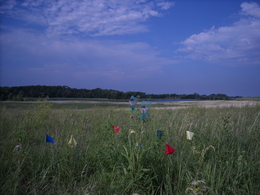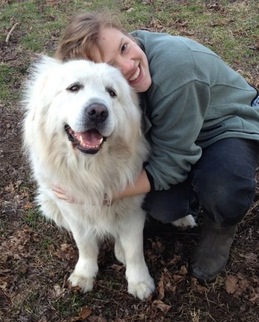|
|

This summer I’m building off of Nicholas’ work with E. angustifolia and E. pallida hybridization. I uploaded my proposal last week, but I’ve already learned a lot since then.
First of all, after first thinking that I should be collecting pollen, painting bracts, observing styles and crossing all on the same day, Stuart pointed out that it would be better to do crosses one day and everything else the next. It makes things go faster, and it is also easier to tell which bracts were painted when. With that in mind I made a bare bones materials and protocol sheet to keep myself organized:
angustifolia_pallidaCrossingProtocol.doc
It worked wonderfully for a few days, when most of the heads were flowering and I didn’t have to keep track of which plant had been sufficiently crossed and which needed more, and then it started getting a little complicated, especially when Gretel found another pallida head to add in….
Talking to Stuart and Gretel a few days into my crossing I found out that I had been crossing in a less efficient manner than I could have been. I had been trying to fit all of my potential crosses onto each head, every time I crossed. This meant that I would have five or six different colors to paint, each with three or four bracts, and that I would have to do the same the next time to have enough styles. Then I had to look back and forth between data sheets to see whether style shriveling was consistent. What I’ve switched to now (for the most part) I think is closer to what Stuart had in mind. Now I try to paint six bracts for each cross, and just alternate crosses. For example, I’ll do three of the crosses one day and three the next time if there are 18 anthers on a head.
Today, Gretel came out to Hegg Lake to help paint bracts, and combined with less switching between colors, it took us about half as long as it has been for the painting and observing.
It also seems like most of my plants will be done flowering soon. A few have already finished, and a few of the plants with large or multiple heads have already been crossed with every possible cross.

Here are two of my Echinacea heads at Hegg Lake, bagged to exclude pollinators and thoroughly flagged to help protect them from being mowed.
This morning we split our time between work on individual projects and observing phenology in the common garden and at Hegg Lake.
I spent my morning at Hegg Lake again crossing the E angustifolia and E paliida that I painted yesterday. And when Gretel arrived to do phenology at Hegg Lake and pick me up she found a new E pallida in its first day of flowering!
Andrew observed his first pollinators on Echinacea with a video camera, and even managed to catch a few for specimens, as well as working on phenology in the common garden.
Kelly went out to observe phenology in some of her remnants, and is starting to see many flowering heads.
Lydia went to make her first compatibility crosses, but had a few problems with cross contamination so will have to make more crosses tomorrow.
Jill and Katherine GPSed the pitfall traps they had set up earlier at Staffanson and Nessman as well as helping with phenology.
Maria had another early morning at Hegg Lake learning about Dichanthelium pollination and found out that Dichanthelium has two sets of anthers.
Greg Dierson also arrived this morning, and will be joining us for a while.
After a long lunch Gretel and Stewart explained the procedure for measuring plants in the common garden, and we completed the first few hours of what is going to be a lot of searching for and measuring plants. Of course, we also got to stand outside and enjoy the day, which thankfully wasn’t quite as hot or humid as yesterday.
Here is the first copy of my project proposal for studying hybridization between E. angustifolia and E. pallida. I’m sure you will see new drafts once I start to have a better idea of how it is all going to work out.
echinacea project proposal.pdf
Last Thursday we planted seedlings from Nicholas Goldsmith’s cross pollination experiment in Josh’s Garden. Here are the data sheets with planting information.
scannedDataSheet_Hybrids_JoshsGarden.pdf
Hybrids_JoshsGarden.csv
Hybrids_JoshsGardenMetaData.doc

Hi everyone! As Andrew reminded us all a few minutes ago, we were supposed to introduce ourselves this weekend and the weekend is just about over, so here it is.
I’m Shona. I’m a rising Junior at Middlebury College in Vermont, where I’m majoring in biology and grew up on a small organic farm also in Vermont. I’m excited to join the Echinacea Project this year, and to get a taste of what biology research is really like. When I am not crouched in the field doing seedling searches or recruitment surveys, I am planing to focus my independent project on hybridization between Echinacea angustifolia and Echinacea pallida. Someday soon I will post a link to my proposal here, once it is a little bit more polished…
This is the first time I’ve been to Minnesota, and I’m looking forward to exploring and enjoying the beautiful landscape and all of the wildlife (I had no idea that Pelicans lived out here!), and getting to know the rest of the group better. I’ve only been in K town for a week but I can already tell that I’m going to be happy here!
I’m sure I will add on to this more later, but here is my project proposal as it is right now:
echinacea project proposal.pdf
We just reorganized the bee collection into a cornell drawer, and need a cabinet to start storing drawers. Once we have better humidity control in the Hjelm house this is the cabinet we are considering.
cabinet
|
|



